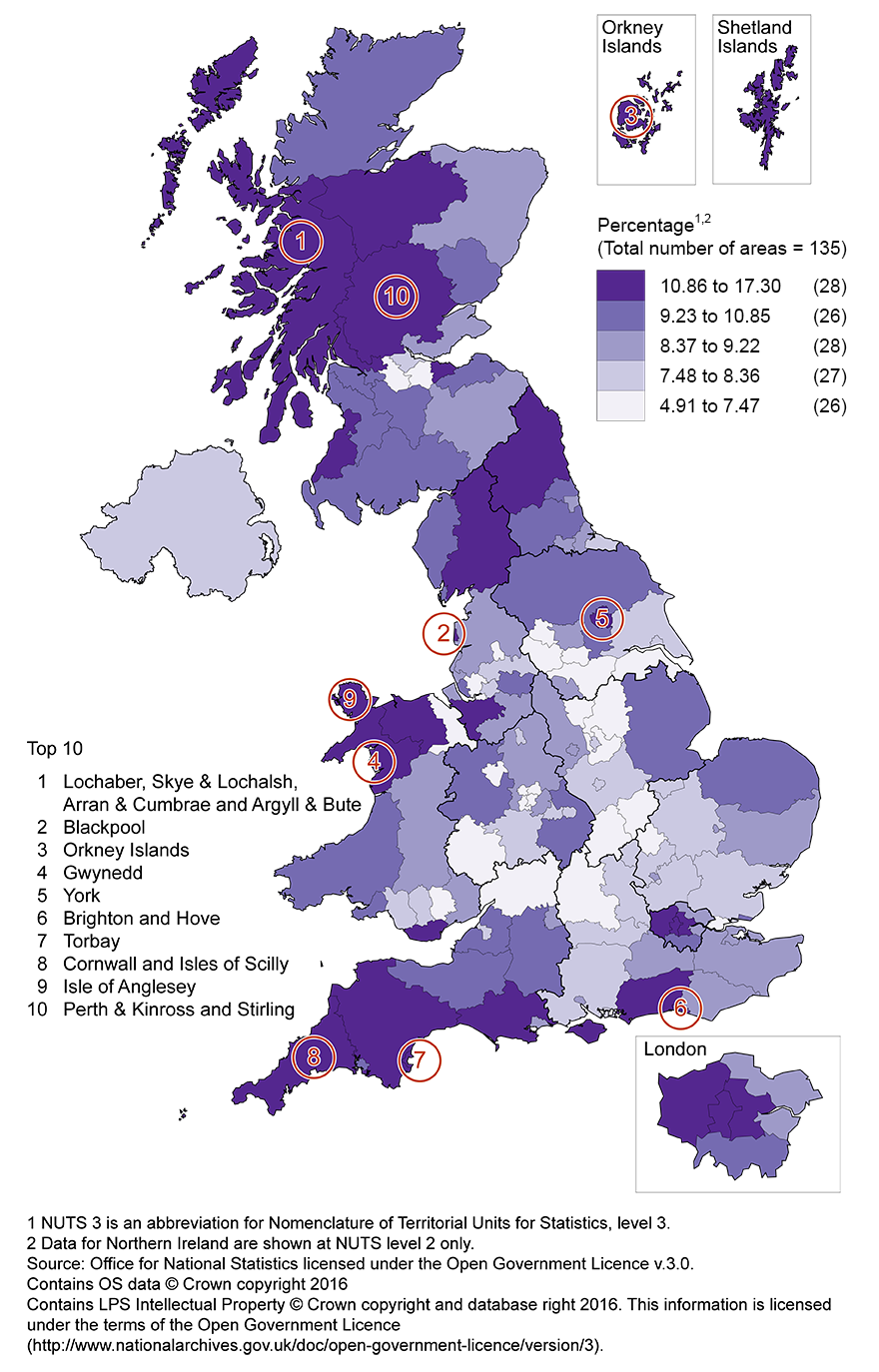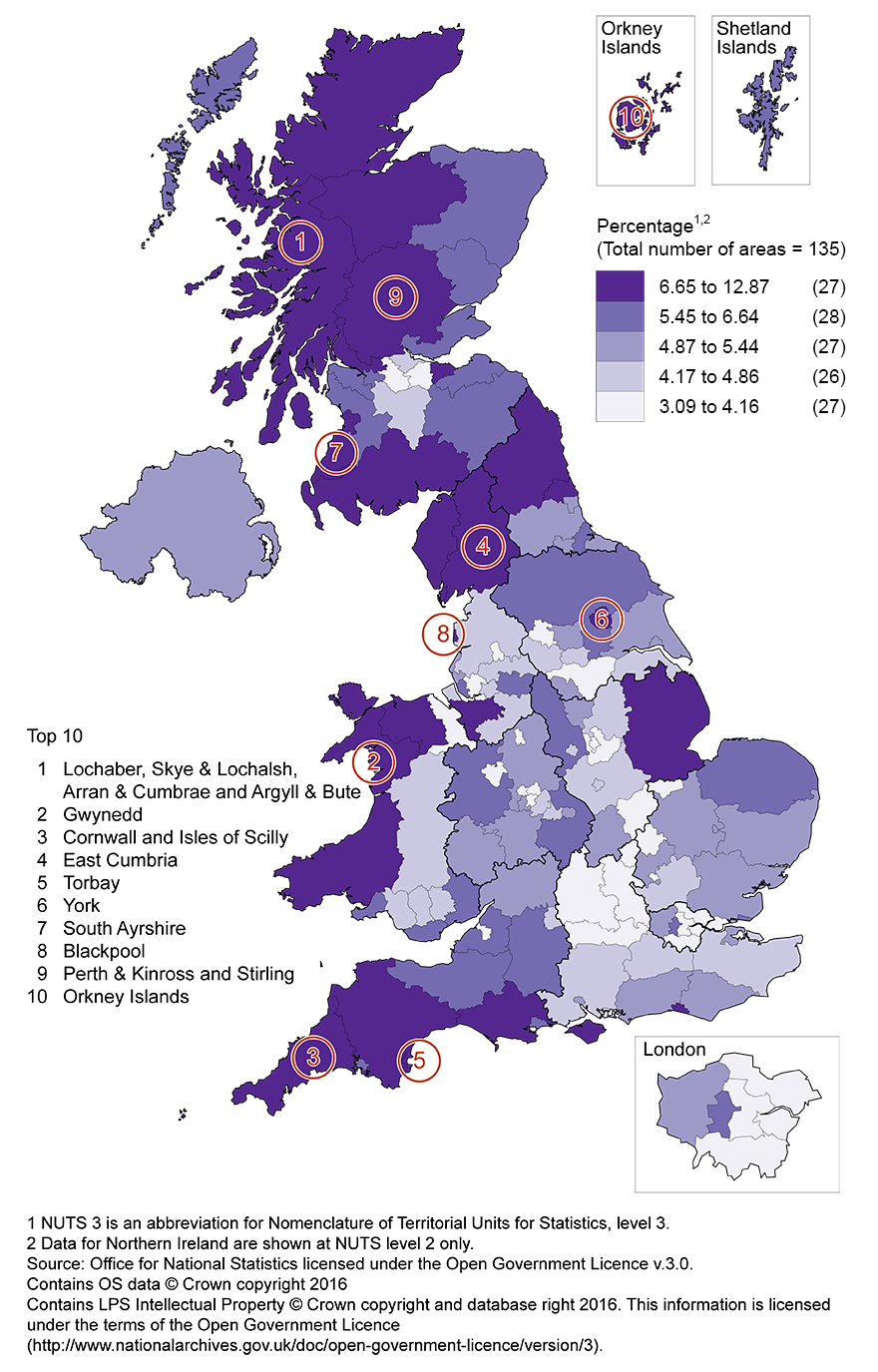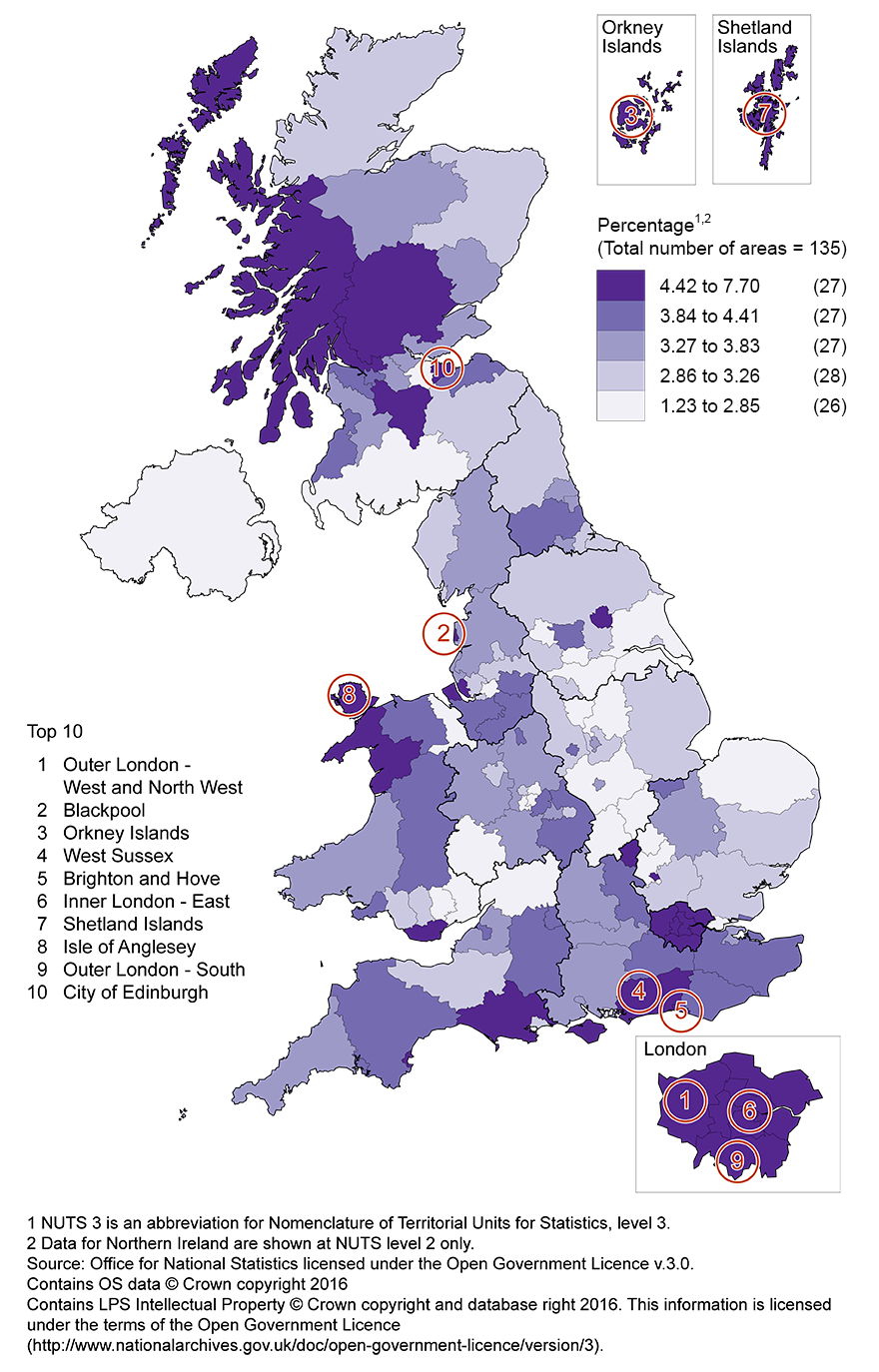1. Main points
Employment in UK tourism industries increased between 2009 and 2014, from 2.66 million to 2.97 million
The largest contributor to this increase is the number of main and second jobs in food and beverage serving activities, which has increased by approximately 170,000 jobs
Almost 50% of workers in culture, sports, recreation or conference activities work either a Saturday, Sunday or both
Only 5.04% of tourism workers are casual employees; 89.57% of tourism workers are permanent; 5.39% of tourism workers are in other forms of temporary employment
2. Introduction
This article analyses a range of data related to the "supply side" of tourism, in other words the industries and services that provide goods and services to tourists. These "tourism characteristic industries" are analysed here in terms of the changes in tourism employment, the regional distribution of tourism employment and the characteristics of those employed in the tourism sector.
The data in this article comes from the Annual Population Survey, 2008 to 2014 (ONS).
Back to table of contents3. Tourism employment trends
Table 1 shows the changing employment numbers within the UK tourism industry groups, the UK tourism industry and the UK non-tourism industry. This shows an increase of approximately 312,000 main and second jobs in tourism between 2009 and 2014. Employment in the tourism industry grew by 11.72 % over this period compared with a growth of 5.11% in non-tourism industry employment.
Table 1: Changes in tourism employment (main and second jobs), 2009 to 2014
| UK | ||||||
| Industry Group: | Employment thousands | |||||
| 2009 | 2010 | 2011 | 2012 | 2013 | 2014 | |
| Accommodation for visitors | 336 | 340 | 347 | 352 | 360 | 388 |
| Food and beverage serving activities | 1,138 | 1,167 | 1,179 | 1,204 | 1,238 | 1,308 |
| Passenger transport, vehicle hire, travel agencies etc. | 497 | 518 | 501 | 507 | 500 | 503 |
| Cultural, sports, recreational & conference etc. activities | 692 | 703 | 695 | 690 | 709 | 775 |
| Subtotal: Tourism industries | 2,663 | 2,729 | 2,722 | 2,754 | 2,805 | 2,975 |
| Subtotal: Non-tourism industries | 27,078 | 27,035 | 27,213 | 27,396 | 27,838 | 28,461 |
| Total: all industries | 29,741 | 29,764 | 29,935 | 30,150 | 30,643 | 31,436 |
| Source: Annual Population Survey 2009-2014, Office for National Statistics | ||||||
Download this table Table 1: Changes in tourism employment (main and second jobs), 2009 to 2014
.xls (33.8 kB)Figure 1 shows the percentage of main and second jobs in tourism industries annually from 2008 to 2014. It shows that, overall, employment in the tourism industry in the UK has increased from 8.29% (2.50 million) to 9.46% (2.97 million) of total employment; this is an increase of 18.78% over 6 years. The percentage of main and second jobs in 3 of the 4 tourism industries reflect this steady increase over time, however, the percentage of main and second jobs in tourism industries within passenger transport, travel agencies and vehicle hire etc. peaked in 2010 and then steadily decreased.
Figure 1: The percentage of jobs in specific tourism industry sectors, 2008 to 2014
UK
Source: Annual Population Survey (APS) - Office for National Statistics
Download this chart Figure 1: The percentage of jobs in specific tourism industry sectors, 2008 to 2014
Image .csv .xlsFigure 2 charts the percentage change in main and second jobs in tourism industries by sector, as well as in all tourism industries and non-tourism industries. This chart shows that the proportion of jobs in tourism industries has increased by 18.78% since 2008, whereas the proportion of jobs in non-tourism industries has fluctuated. This is largely caused by the increase in main and second jobs in food and beverage serving activities and culture, sport, recreational and conference activities respectively between 2008 and 2009 (11.50% and 11.20% respectively). The decline in the percentage of jobs in non-tourism industries can be explained by the growing proportion of jobs in tourism industries in the economy, rather than the direct decrease in number of jobs within non-tourism industries.
Figure 2: The percentage change in tourism employment by sector, 2008 to 2014
Source: Annual Population Survey (APS) - Office for National Statistics
Download this chart Figure 2: The percentage change in tourism employment by sector, 2008 to 2014
Image .csv .xls4. Age and sex of tourism workers
Figure 3 shows the distribution of ages of workers in both tourism and non-tourism industries in 2014. The chart shows that the profile of tourism workers is generally younger, with 26.40% of tourism workers being between the ages of 16 and 24, compared with only 10.50% in non-tourism industries.
Figure 3: Population pyramid showing the age distribution of workers in tourism and non-tourism related industries, 2014
UK
Source: Annual Population Survey (APS) - Office for National Statistics
Download this chart Figure 3: Population pyramid showing the age distribution of workers in tourism and non-tourism related industries, 2014
Image .csv .xlsFigure 4 shows the distribution of tourism workers by both age bands and sex. It can be seen that the distribution of workers is fairly even through the age groups, although there is a higher percentage of females between 16 and 24 than is the case for males (29.30%, compared with 23.70%).
Figure 4: Population pyramid showing the age distribution of male and female workers in tourism industries, 2014
UK
Source: Annual Population Survey (APS) - Office for National Statistics
Download this chart Figure 4: Population pyramid showing the age distribution of male and female workers in tourism industries, 2014
Image .csv .xlsFigure 5 shows the percentage of tourism workers by age, this time split into 4 age bands, by region of the UK. The percentage of workers in each age group is mostly consistent, with a high proportion of workers being 16 to 29 years old, with the exception of London. London has a higher percentage of workers age 30 to 44 with a slightly lower percentage of other age groups.
Figure 5: The age distribution of tourism workers across UK regions in 2014
UK
Source: Annual Population Survey (APS) - Office for National Statistics
Download this chart Figure 5: The age distribution of tourism workers across UK regions in 2014
Image .csv .xlsFigure 6 shows the age of tourism workers across the 4 sectors of main tourism employment. There is a high proportion of 16 to 29 year olds working in food and beverage serving activities, more than 50% (this figure was adjusted 4 February 2016, 14:00), whereas in the transport industries there is only a small percentage of 16 to 29 year olds. The accommodation for visitors industry has a higher proportion of workers aged 60 and over.
Figure 6: The age distribution of tourism workers by industry sector in 2014
UK
Source: Annual Population Survey (APS) - Office for National Statistics
Download this chart Figure 6: The age distribution of tourism workers by industry sector in 2014
Image .csv .xls5. Geography of tourism employment
Figure 7 shows the "top 10" regions where employment in tourism characteristic industries is more than 13.50% of all employment. The region of Lochaber, Skye and Lochalsh, Arran and Cumbrae, and Argyll and Bute has the highest percentage of main and second jobs in tourism characteristic industries, with 17.29%.
Figure 7: Main and second job employment in tourism industries as a percentage of total employment, NUTS 3, 2013 to 2014
UK

Source: Office for National Statistics
Download this image Figure 7: Main and second job employment in tourism industries as a percentage of total employment, NUTS 3, 2013 to 2014
.png (561.1 kB)Figure 8 shows the "top 10" regions where employment in accommodation and food and beverage serving activities is more than 8.40% of all employment. The region of Lochaber, Skye and Lochalsh, Arran and Cumbrae, and Argyll and Bute has the highest percentage of main and second jobs in accommodation and food and beverage serving activities, with 12.87%.
Figure 8: Main and second job employment in accommodation and food and beverage serving activities as a percentage of total employment, NUTS 3, 2013 to 2014
UK

Source: Office for National Statistics
Download this image Figure 8: Main and second job employment in accommodation and food and beverage serving activities as a percentage of total employment, NUTS 3, 2013 to 2014
.png (560.6 kB)Figure 9 shows the "top 10" regions where employment in "other" tourism characteristic industries (this includes culture, sport and recreation activities and passenger transport, travel agencies, car hire, and conference activities) is more than 5.50% of all employment. Outer London (West and North West) has the highest percentage of main and second jobs in other tourism characteristic industries, with 7.69%, reflecting the focus on passenger transport as this is the location of Heathrow Airport.
Figure 9: Main and second job employment in other tourism characteristic industries as a percentage of total employment, NUTS 3, 2013 to 2014
UK

Source: Office for National Statistics
Download this image Figure 9: Main and second job employment in other tourism characteristic industries as a percentage of total employment, NUTS 3, 2013 to 2014
.png (554.1 kB)6. Highest qualifications of tourism workers
Figure 10 shows the highest qualification level achieved for tourism workers in comparison with workers in other industries. It can be seen that 30% of tourism workers have achieved a qualification level of degree, higher education or equivalents, whereas 42.90% of workers in other industries have a qualification of that level. The majority of tourism workers have a qualification level above GCSE grades A*-C (or equivalent), although it falls below the percentage of non-tourism workers with a similar level of qualification (78.90% to 85.60%).
Figure 10: The percentage of each workers in tourism industry sectors compared with non-tourism industry sectors, based on their highest achieved qualification level, 2014
UK
Source: Annual Population Survey (APS) - Office for National Statistics
Download this chart Figure 10: The percentage of each workers in tourism industry sectors compared with non-tourism industry sectors, based on their highest achieved qualification level, 2014
Image .csv .xlsFigure 11 compares the highest qualification level of tourism workers in the 12 different regions of the UK. It can be seen that London has a much higher percentage of workers with a degree or equivalent level qualification in tourism industries in comparison with the other UK regions. More deprived regions of the UK, for example, the West Midlands and Northern Ireland, have a higher percentage of tourism workers with no qualification (11.30 and 16.50% respectively).
Figure 11: The percentage of workers in each UK region based on their highest achieved qualification level, 2014
Source: Annual Population Survey (APS) - Office for National Statistics
Download this chart Figure 11: The percentage of workers in each UK region based on their highest achieved qualification level, 2014
Image .csv .xls7. Working patterns of tourism workers
It can be seen from Figure 12 that all tourism industries have a higher than average proportion of employees working on either a Saturday, a Sunday or both. Compared with the other tourism industries, food and beverage serving activities has a lower percentage, almost by 10%, of workers working at the weekend. However, this is more likely to be a reflection on the size of the food and beverage industry and the volume of employees that could be available to work on a weekend. The other industry to highlight is the culture, sports, recreation and conference activities industry, which has almost half of its employees working some part of the weekend (49.50%).
Figure 12: The percentage of tourism workers who worked either a Saturday and/or Sunday by industry sector, 2014
UK
Source: Annual Population Survey (APS) - Office for National Statistics
Download this chart Figure 12: The percentage of tourism workers who worked either a Saturday and/or Sunday by industry sector, 2014
Image .csv .xlsThere are approximately 1.74 million (58.90%) full-time workers in tourism related industries and 1.22 million (41.10%) part-time workers in the tourism industry.
The reasons behind part-time work in tourism industries are further explored in Figure 13.
Figure 13 shows the percentage breakdown of tourism workers employed on a part-time basis based on the reasons for part-time work. This highlights that the highest proportion of part-time workers in tourism characteristic industries, 46.40%, specified that they did not want a full-time job, compared with more than 70% of workers in non-tourism characteristic industries. A significant proportion of tourism characteristic industry employees, 20.80%, specified that they could not find a full-time job, whilst 30.20% stated they were students.
Figure 13: The reasons why tourism workers are part-time, 2014
UK
Source: Annual Population Survey (APS) - Office for National Statistics
Download this chart Figure 13: The reasons why tourism workers are part-time, 2014
Image .csv .xls10.43% of jobs in the tourism industry are temporary, compared with only 6.12% of temporary jobs in non-tourism industries. The tourism industries account for 14.43% of all temporary employment in the UK.
Figure 14 charts the reasons why tourism employees are in temporary employment. Temporary tourism employment in tourism characteristic industries is largely made up of casual workers. This means that almost 50% of temporary employees in tourism are not guaranteed future hours, holiday or sick pay and have no set number of hours per week. It should be noted however, that temporary employment represents 10.43% of tourism employment, meaning 5.04% of tourism workers are in this position.
Since 2011, there has been a decrease in the percentage of seasonal temporary workers. However, these employees could also be considered “casual” which may explain the sharp increase of casual workers between 2011 and 2014. A striking difference between the different types of temporary employment between tourism and non-tourism characteristic industries is the large proportion of fixed contracts in non-tourism characteristic industries, compared with the large amount of casual workers in the tourism industry.
